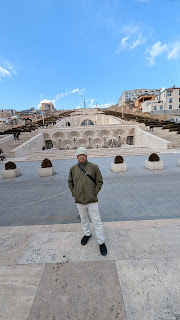2. The Christians of Madras give credit to Armenians for locating the tomb of St. Thomas, the Apostle who brought Christian faith to the Indian sub-continent in 52 A.D. The church built by the Portuguese in 1523 was the result of Armenian Merchants taking them there in 1517. Two centuries later, another Armenian trader built 160 broad stone steps that led to the hilltop shrine. Pilgrims, to this day, benefit from the 18th century work of an Armenia trader.
3. Madras was also the birthplace of Armenian journalism and the home of Father Haroutiun Shmavonian who published the first Armenian periodical in the world, the Azdarar, in 1794.
4. The first full-fledged Armenian colony was established in the town of Agra where the first Armenian church was built in 1562 during the reign of Akbar, the Great. Akbar not only paid for the construction of the church, but in later years took an Armenian woman by the name of Mariam as one of his Queens, appointed Abdul Hai, an Armenian, as his chief justice and took on an Armenian woman doctor, Juliana, to look after his family.5. In Agra's main Christian cemetery on the outskirts of town, is an ancient mausoleum, which also serves as a chapel, and the old tombstones of more than 100 Armenians. An interesting fact is that not a single woman was buried there between 1611 and 1777, an indication that the Armenian men who came to Agra for trade left their wives and families behind.
6. One of the prominent Armenians of Delhi in the late 1700's was Colonel Jacob Petrus, the son of an Armenian merchant from Yerevan, Armenia, who made a name for himself fighting on the side of the Scindiahs against British colonialists in Gwalior. When he died in 1870, instead of a traditional 21-gun salute, he was given a farewell with a 95-gun salute, representing his age.7. Sarmad, the Armenian merchant cum Sufi poet, came to India during the reign of Emperor Shah Jehan. He was beheaded near the Jama Masjid in Old Delhi in 1611 and his tomb is more than a shrine where many gather to offer prayers even today.
8. The Armenians of Surat were mostly merchants who operated their own private ships for trading with Europe, transporting their products outside India in Armenian-owned ships. The business acumen of Armenians in India was highly regarded by the British who secured their intercession with the Mogul Court for trading privileges in India. An agreement was signed in London on June 22, 1688 between the East India Company and "the Armenian Nation," represented by Khojah Phanoos Kalandar, a native of New Julfa who had settled in Surat.
9. After Bombay was taken over by the British in 1661 Surat lost its luster and Armenians settled in Bombay, where they were not only traders and businessmen but also became prominent in many professions such as medicine.10. Between 1855 and 1893, there were more than 25 Armenian advocates in the Calcutta High Court alone.
11. Though the number of Armenians in India almost never exceeded 20,000, their involvement in every facet of Indian life gave them the kind of prominence and exposure seldom enjoyed by any other community of traders and merchants.
12. There are Armenia streets in Calcutta and Madras even today. Armenian churches are still in Armenian hands, and a small, but determined Armenian community still lives in India with the pride of the contribution of their ancestors as legacy. There are seven Armenian churches and two schools in India – 3 in Kolkata, one each in Chinsurah, Saidabad, Chennai and Mumbai.











No comments:
Post a Comment